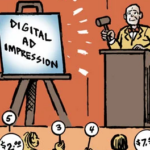“On TV & Video” is a column exploring opportunities and challenges in advanced TV and video.
Today’s column is by TJ Sullivan, EVP of sales at Digital Remedy.
As the consumer journey has grown more complex, marketers have been forced to extend campaigns across a diverse ecosystem of devices and platforms. That, in turn, has made attribution much more challenging – particularly in CTV/OTT advertising.
Today, it takes an average of 56 touch points before a consumer makes a purchase. Determining which of those touch points truly sealed the deal feels seemingly impossible. The reality is it likely wasn’t just one exposure. Rather, it was probably a series of carefully timed and curated engagements on specific channels and devices – an experience unique to each consumer.
With only first- and last-touch measurement, advertisers are missing out on the full chain of impressions and how their inter-dependency drove a desired action.
Enter multi-touch attribution (MTA), the only effective way to fully understand the customer journey. This essential measurement strategy allows marketers to identify the specific touch points throughout the journey on CTV (and beyond!) that triggered a desired action – and then leverage those insights to optimize future campaigns.
With multi-touch attribution, each touch point or creative may carry a different weight, but all are taken into account. For example, in a time-decay MTA model, credit increases as time to conversion decreases. In a linear MTA model, credit for a conversion is distributed equally across all touch points. Simply put, it paints a fuller picture.
With multichannel content consumption consistently on the rise, marketers need to get smarter about measurement. Supercharge your advertising strategy by leveraging these alternative attribution methodologies.
Step 1: Define your attribution timeframe
How far back in time can an ad still influence an action? It depends on your brand and goals. Define this timeframe and exclude exposures outside that window. Then, decide how you’ll weigh every touch within it.
Remember, correlation is not the same as causality. Just because it looks like the conversion was driven by a series of impressions, looks can be deceiving. Maybe that person was a long-standing fan and intended to purchase anyway. Maybe they read an article highlighting your brand, and that PR initiative – completely separate from your CTV ads – ultimately drove them to take action. It’s impossible to know without considering all the factors at play.
Step 2: Get incremental
Incrementality analysis evaluates attributed conversions and filters out ones the campaign didn’t directly drive. This requires measuring the conversion rate lift of an exposed viewer against a holdout group. In the modern ad landscape, there will be overlap between individuals who saw ads on different mediums. Incrementality allows brands to isolate the effect of a particular media type to accurately determine its impact, measuring which desired actions, such as purchases or site visits, occurred as a direct result of a brand’s campaign or variable within a campaign.
With incrementality analysis eliminating conversions from the measurement model that would have happened anyway, advertisers can see a more accurate reflection of their CTV campaign effectiveness. Without this type of analysis, this channel exists in a vacuum, not as part of a larger, more holistic performance strategy.
Step 3: Optimize in real time
What good is data if you don’t put it to work right away? The beauty of CTV is that it enables real-time optimization of ad buys and delivery in a way linear TV definitely cannot. That means as soon as advertisers have insight into attribution, they should move their budget toward the publishers, creatives, dayparts, audiences and geographies that are working to drive the most action to fully maximize spend.
Sophisticated CTV platforms treat each campaign like real-time A/B tests. For example, if a “millennial women” audience segment is outperforming “Gen Z women” or a 15-second creative is outperforming a 30-second creative, this data is used to inform media buying with a bidder that moves budget toward the highest performing campaign variables – in this case, “millennial women” with that 15-second creative.
While it may be relatively new to some marketers, multi-touch attribution must become a top priority in CTV advertising strategy. By leveraging multi-touch attribution coupled with granular incrementality analysis, advertisers can effectively determine what’s making a true impact – and take swift action to drive higher return on ad spend.
Follow Digital Remedy (@cpxi) and AdExchanger (@adexchanger) on Twitter.













